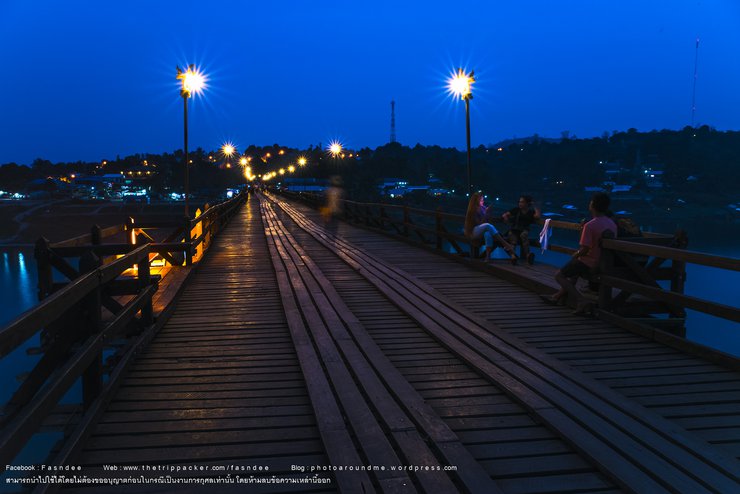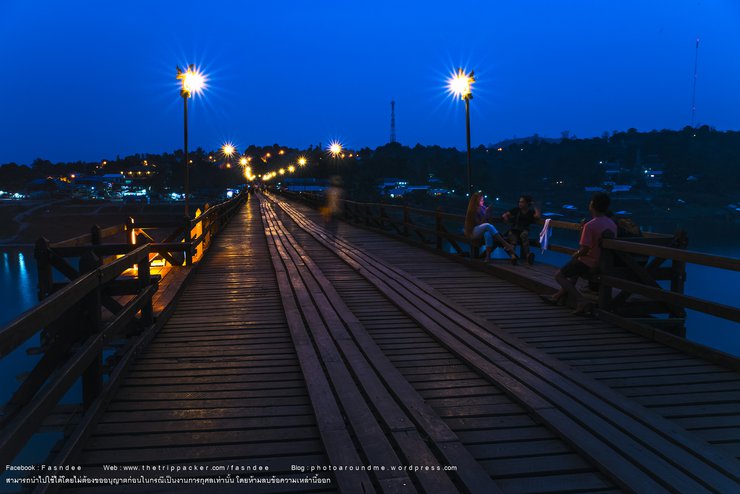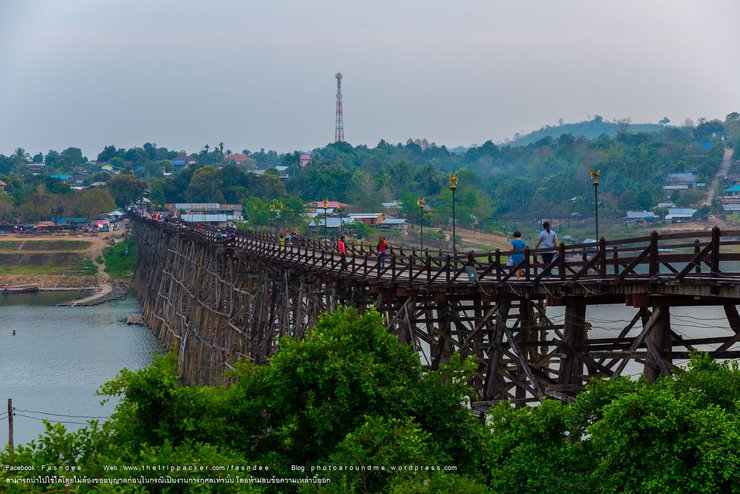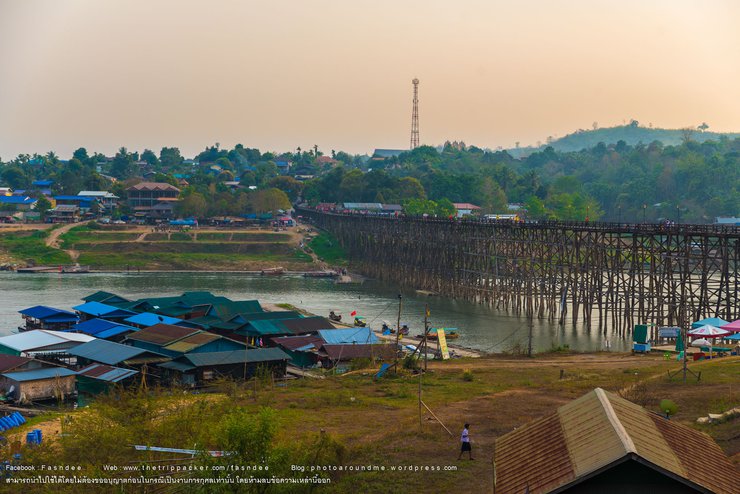
The U Bein Bridge, also known as the U Taung Bridge, is the longest wooden bridge in Thailand and the second longest in the world. My recent trip to photograph this bridge was more rewarding than I expected. I had a general idea of the photos I would capture and the pleasant atmosphere I would encounter, as well as glimpses into the lives of local people. However, I did not anticipate the depth and authenticity of these experiences. I initially feared that some aspects might be staged for tourists, but I was pleasantly surprised to find that this was not the case.
The atmosphere is fantastic, not just good, but truly exceptional. The wooden bridge exudes a genuine sense of relaxation. People stroll, walk, and chat on the bridge, bathed in the deep blue sky as the sun sets. The bridge features eight small, protruding benches, perfect for soaking in the ambiance. Tourists often choose to sit here, savoring the atmosphere instead of a meal. The gentle breeze, the flowing water, and the people create an experience that surpasses words. It's something you have to experience for yourself.
The daily life of the Mon people is more authentic than it appears. While some may carry offerings on their heads for tourists to photograph, it is a common practice for them to do so in their daily lives. Early in the morning, before dawn, I witnessed Mon women chatting on the bridge as they prepared offerings for the monks or opened their shops. This is a regular occurrence for them.
I was fortunate to visit during the annual temple festival, which features 24-hour chanting from dawn to dusk for nine consecutive days, from March 5th to 13th each year. The owner of the house I rented, Uncle Sommai, took me and his elderly relatives, who were about the same age as my grandmother, to the temple late at night to chant at this merit-making event. It was a celebration of the birthday of Luang Pho Uthama, who is highly respected. I listened to Uncle Sommai's stories and could feel that the local people truly revered him. The Mon Bridge was also built thanks to his efforts.
Having provided sufficient background information, I will now proceed to copy and paste the information I have already written in my review. On February 23rd, I visited Kanchanaburi and planned to hike to several points, with the Mon Bridge being my final destination. However, due to unforeseen circumstances, I had to stop my journey at Erawan Waterfall and promised myself that I would return soon. On March 10th, I finally made it to the Mon Bridge. My itinerary for this trip was as follows:
Bangkok - Mon Bridge (overnight camping) - Huay Song Kalaria - Three Pagodas Pass - Wat Sao Roi Ton - Fort Pi (overnight camping) - Death Railway (Tham Krasae Station)
All traveled by their own motorcycles. This thread will only discuss the Mon Bridge.
- - - - - - - - - -
March 10, 2016. Left home at 9:00 AM and arrived at the Mon Bridge at 3:00 PM. I took a random route and briefly checked out the location of Fort Pi. This made me arrive later than expected, but not too late. I arrived at the viewpoint, where camping is free and there is a separate parking lot. There are toilets, but I didn't see any showers. I came today and haven't seen anyone camping yet. I'm not sure if there will be more people later in the evening. However, there are many camping spots here, including pavilions, so you don't have to worry too much about dew and rain. But if you come on a weekend, you may not be able to choose your camping spot because there will probably be a lot of people. (For information on the camping spots, please see the posts below.)

The Mon Bridge on an ordinary day
I factored in time for a preliminary exploration, as it seemed that setting up a tent at the viewpoint and leaving it unattended to take photos could result in the loss of belongings. The area was sparsely populated, unlike national parks where I have camped and left my tent to roam and take photos, securing it with a lock without fear of theft. However, here, I was unsure.

After exploring several options, I chose "Sommai Homestay" as my accommodation (I will post information about this accommodation below). This establishment also operates as a restaurant. Here is a summary of the information about the accommodation:
A la carte restaurant
There are two separate guest houses, each standing alone and located a short distance from each other.
The first house has air conditioning, the other has a fan. Price 800 / 500 baht / night
Prices are higher on Fridays and Saturdays.
The kind owner was open to negotiation. I mentioned that I might stay for several nights and requested a lower price. He offered a 100 baht discount and agreed to keep the same rate if I extended my stay until Friday and Saturday.
En suite bathroom with hot water available.
King-size bed, comfortably sleeps two.
There is a TV.
The accommodation is conveniently located just a 3-minute walk from the Mon Bridge. Situated in a quiet lane where monks perform their morning alms collection, guests can easily participate in this cultural practice.

I arrived at the storage room at 4:00 PM. I ate, packed my things, and took my camera and tripod out to scout locations for morning shots. I also took some photos in the evening light.
The area around the Mon Bridge is home to numerous shops and accommodations, with prices ranging from 300 baht to several thousand. There are many shops and restaurants, as well as a market for souvenirs. However, as I visited during the week, I noticed that only a few shops were open. I expect that on weekends, the area would be bustling with activity and many more shops would be open.

Certainly, the young tour guide ran up to me quickly. She was a pretty girl with a memorized speech, which was both funny and endearing. She told me the history of the place, and we chatted for a bit before she left. I asked her if there was a fee, and she said it was up to me. I gave her 100 baht, but I spoke to someone who had been there before, and they said 20 baht would have been enough. It's a shame I didn't take a picture of her because I was in a hurry to see the location before the sunset. However, I did take a video with my action camera, so hopefully, I can use it and the images won't be ruined like my last trip.

The Mon Bridge has benches, which I think is really cool if you come to sit and watch people walk by, enjoying the cool breeze after the sun has set. It feels really good and relaxing. I highly recommend it. However, if you come on a weekend, you probably won't be able to sit down.
The provided text is empty. There is nothing to translate.
And near the Mon Bridge, there is also a red bridge that you can walk across to another point.

I'd planned to stay here until the holidays, as my next destination isn't far from here and the plan was to stay here (although the original plan was to camp, which would have been free).
Note: This text may be confusing as it is copied from a daily review I wrote on another website.









The Mon Bridge path... treading from dawn until the sky brightens.
The provided text is empty. There is nothing to translate.

On March 11th, I woke up at 4:45 AM, took a shower, and brought out my camera to prepare for the morning life here. After being impressed by the relaxed atmosphere at the bridge last night, I believe that the morning will also have interesting highlights.

Many of the Mon people here are friendly. Well... I'm not sure if the person who walked by and greeted me was Mon or not. Because here there is a market that sells Mon clothes. Some shops, some houses, and some accommodations also offer Mon costume rental services for playing or alms giving. Thinking like this, I think the person who greeted me might be a tourist instead, because their accent is not native.
In addition to the friendly locals, some dogs are just as friendly. Like this one, it walked with me from the foot of the bridge. When I stopped, it stopped. Sometimes it would come in as a model that wasn't very happy to stay still. When I walked on, it followed me. Until sometimes I accidentally let it slip between the tripod legs (it came in on its own, I didn't put it there).

Despite the early hour and the lack of daylight, the bridge was already bustling with activity. Pedestrians crossed sporadically, but their numbers steadily increased with each passing minute. This surge in foot traffic was likely due to the many people who had come to participate in the alms-giving ceremony, or to observe the Mon people offering alms. The monks remained on the Mon market side of the bridge, avoiding the side with the numerous hotels and resorts. As a result, those wishing to offer alms had to hurry across the bridge.

The early-rising Mon people, some having finished their chores and preparations, stood chatting in the middle of the bridge. Others hurried to open their shops selling food for alms. The Mon market side of the bridge started bustling even before 5:30 am, but it was a quiet bustle of vendors mixed with the sound of chanting from a sound system. I'm not sure if it's open every day (it probably is), but during my visit, it was the annual religious festival, with chanting going on all day and night for nine days, from March 4th to March 13th of each year. This is because it is the birthday of an important local monk (who has passed away) who was instrumental in the construction of the bridge. After the nine days of religious ceremonies, there will be five days of festivities, which the children here will enjoy, with games and activities for them to participate in. Anyone who wants to chant all day or all night until morning can come during this time of year.

The sky began to turn from blue to purple, signaling the approaching sunrise. It was time for the monks to make their daily rounds for alms collection. Tourists started to gather in small groups, and we could hear the occasional call in the Mon language urging people to hurry as the monks were arriving.



The monk will walk down this alley, turn into another one, and then likely return to the temple. Originally, the monk would not receive alms in this alley. However, I heard that previously, the monk would directly receive alms at the main alley leading to the bridge. But the vendors there often fought over customers, so the monk started avoiding that alley and instead walks through this side alley, which is only a few dozen steps away.
Vendors will set up stalls to sell offerings for alms-giving and arrange chairs in rows for tourists who wish to participate. They can place their offerings on the chairs, ready for the monks to collect.



Other shops in the market are gradually opening up as more and more tourists come to enjoy the morning breeze after offering alms. The Mon market is located at the bridge and under the bridge, selling clothes, accessories, and souvenirs. There are no large hotels in this area, but there are houses that have been converted into homestays or, at most, small shophouses that are rented out. This is in contrast to the other side of the bridge, which has larger business-oriented accommodations. If you want to experience the local way of life, it is better to stay on this side.




The vibrant colors of the Mon Bridge are a reflection of the Mon people themselves. Aside from the young tour guides, you will see Mon people dressed in traditional attire walking around. Some children even carry items on their heads, as if they are putting on a show for tourists to take pictures with. I often saw this young girl walking around, both in the morning and evening. Many tourists asked to take pictures with her, but I never saw her ask for money.


Joining forces with other groups, but in the group, no one stands out more than this child. He is a smart child who knows what tourists want. Tourists who bring their children, some children do not dare to stand and take pictures with them, or their parents do not say anything. This Mon child will walk up to the children of the tourists and stand with them so that the tourists can take pictures of their father and this child with the tourists' child.
The scene was hilarious when this young man approached a seemingly apprehensive tourist child and said, "Come here, I won't bite." Despite the child's apparent fear, they were unable to resist being pulled in for a hug and a photo. The child's parents, amused by the situation, captured the moment with their camera.
The provided text is empty. There is nothing to translate.


In addition to the child actor, there were also real Mon children who carried offerings on their heads to sell or deliver.

Exhausted, the puppy and the kitten took a break.

Life at this bridge continues on its leisurely course. Some days, musicians come to busk, strumming their guitars and singing songs. Others come to show off their diving skills, while some prepare their boats to await customers. Tourists, meanwhile, relax and unwind, living up to the bridge's reputation as a haven for laid-back vibes.
This is an empty paragraph.






Information about the homestay accommodation where I stayed
The area around the Mon Bridge offers a variety of accommodations, including guesthouses, hotels, homestays, and rental rooms. I chose to stay at "Sommai Homestay" because it is conveniently located near the bridge (within a 4-minute walk) and also serves delicious food. I observed that many customers came from other places specifically to enjoy the restaurant's cuisine, even considering their visit to the Mon Bridge as secondary.

The food prices are reasonable, with a single dish like stir-fried chicken with basil costing 40 baht. However, the portion sizes are significantly larger than those found in Bangkok. The garlic and pepper pork dish is also noteworthy, with the addition of vegetables enhancing its presentation and flavor. One minor drawback is the preparation time, as the uncle and aunt who run the kitchen take their time. If you have a large group, it's advisable to place your order in advance. You can then explore the area while they prepare your food. They can even deliver it to your accommodation if you're staying elsewhere. The kitchen typically closes around 8 pm, but they will continue cooking until all guests have been served.
The accommodation consists of individual bungalows, each with a private bathroom equipped with a shower and water heater. The bedrooms feature a queen-size bed suitable for two guests. The fan-cooled room includes a television, while the air-conditioned room, which I did not personally inspect, reportedly accommodates up to five individuals.
The provided text is empty. There is nothing to translate.

The uncle is kind and the price is negotiable, especially for those who plan to stay for more than 1 night. The normal price of the room is
- Fan room 500 baht per night.
- Air-conditioned room for 1000 baht per night.
However, if you come with a large group and the beds are full, Uncle allows you to pitch tents inside the house free of charge. For those who plan to camp without renting a room, Uncle only asks for a small fee for water and electricity.
For those staying multiple nights, especially on weekdays, you may be able to negotiate a lower price with the uncle.
If you plan to visit on Friday, Saturday, or Sunday, be aware that the guesthouse only has two rooms available. Although the owner claims to be one of the first to offer accommodations in the area, the limited number of rooms often leads to full occupancy, especially during peak seasons. It is highly recommended to book your stay at least two weeks in advance to avoid disappointment.
This is an empty paragraph.
Phone number 089-079-0969. Uncle provides services including accommodation, food delivery, and boat tours.





Scenic viewpoint at the Mon Bridge. Free tent camping. Toilets and bathrooms available. No worries about rain or heat.
This was the spot I had planned to camp at from the beginning. Not only was it free, but it also had everything I needed, including bathrooms, toilets, a clean concrete floor for pitching my tent, and a roof to protect me from the rain and sun. Most importantly, there was electricity available, and some spots even had outlets for charging my phone.


The entrance is clearly marked as a viewpoint. Turning in, you will find a large outdoor parking lot, which may be crowded on weekends or holidays. On weekdays, as seen in the picture, there is no one around. This made me hesitate to set up my tent and leave it unattended to take photos, as I was afraid of my belongings being stolen. There are usually teenagers wandering around, and while it would be difficult for someone to break into a tent and steal something with many tourists around on weekends, on weekdays like this, with no one around, it's a different story.


Entering from the parking lot, you will find the pavilion where you can pitch your tent. Nearby, you will find restrooms. There are also restrooms downstairs, but the staff advises using the ones upstairs. There are several toilet stalls, but only one shower room.




After exiting the first pavilion, you will encounter a walkway currently undergoing repairs and repainting. You may notice painting supplies scattered on the ground, but these should be cleared within the week. As you descend the stairs, you will see a fork in the path leading to additional pavilions on the left and right. Continuing down the path, you will reach a spacious open area. During the day, the area can be quite hot in the summer, but the evenings and early nights offer cooler temperatures. As night falls, the temperature may drop further. In the winter, the area is expected to be cold, possibly even frigid. Some have reported seeing mist rising from the river's surface during the winter months.






The viewpoint offers a variety of flora and a glimpse of the Mon Bridge. While the view may appear picturesque in photos, the bridge is actually quite distant. It's recommended to approach the bridge for a closer look.

The Mon Way of Life: Faith and Culture
This phrase captures the essence of the Mon people's identity, highlighting their unique blend of faith and cultural practices.
- วิถีชาวมอญ (Wíthí chāo Mǒn): This translates to "the way of life of the Mon people," emphasizing their distinct traditions and customs.
- ศรัทธา (Sà-rát-thā): This signifies "faith," underscoring the importance of religious beliefs in shaping the Mon worldview.
- วัฒนธรรม (Wát-tha-na-tham): This refers to "culture," encompassing the diverse artistic expressions, social norms, and values that define the Mon community.
By combining these elements, the phrase paints a vivid picture of the Mon people's rich heritage, where faith and culture are intertwined, shaping their daily lives and perspectives.
I was fortunate to visit the Mon Bridge during a significant local festival coinciding with the birthday of the revered Luang Pho Uthama. The deep respect for Luang Pho was evident in the tone and demeanor of the local homeowner who shared the story. Luang Pho is credited with driving the development of the Mon Bridge, and his legacy continues to be celebrated. Sadly, he has passed away, but his memory is honored through the annual nine-day festival, which features vibrant festivities from dawn to dusk.

Elderly people take turns visiting the temple at all hours of the day. In the mornings, we see adults bringing children to the temple to make merit and participate in religious activities. This is a positive aspect of the community, as it instills in local children an understanding of their cultural roots and helps to preserve traditions.

After the nine-day merit-making ceremony, a five-day festival followed, featuring various forms of entertainment. I returned home before the festival, only stopping by to take some photos of the morning merit-making ceremony.
The essence of the Mon Bridge lies not only in its structure, but also in the opportunity to witness the authentic culture and way of life of the Mon people. This goes beyond merely observing them in traditional attire. Immersing oneself in their cultural practices, especially during festive occasions, evokes a deeper sense of appreciation than simply admiring the bridge.




เดินทางตามฝัน
Friday, September 27, 2024 10:22 AM
















